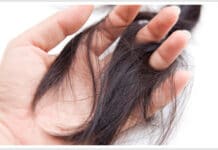
SWEET TASTE INSTINCTS RUN DEEP, BUT ARE SWEETENER SUBSTITUTES LIKE ASPARTAME AND SACCHARINE DEEPLY FLAWED?
Does sugar contribute to hair loss? Maybe. When you consume refined sugar, it triggers your pancreas to produce more insulin. Too much sugar — and insulin in overdrive — leads to a series of events (too complicated to go into here) around androgen receptors in hair follicles. In theory, this may increase hair loss, in combination with other factors. However, clinical cause-and-effect studies have never been performed to confirm this possible relationship.
In any event, humans obviously have a deep-seated need for a sugar fix. An 8,000-year-old cave painting in Valencia, Spain, depicts a man harvesting honey by way of what appears to be a precarious rope ladder on a cliff wall. Ever since, we’ve figured out ways to extract sweetness from sugarcane, corn, agave, apples, grapes, dates, and just about every other fruit known to humans (and some vegetables, such as beets and carrots). Bee honey is produced on a massive scale in the 21st century.
It’s interesting to ponder what drives this instinct: Sweetness is the evolutionary equivalent of sex. The pleasure is what draws us in, but the calories and nutrients associated with fruit sugar — for example, all the macro-and micronutrients and fiber present in fruits and vegetables — gave our species a better shot at survival.
The cavemen had to work hard to get that honey, but they survived and passed their sweet-loving genes down to us. Fast-forward to the 20th century, when we figured out how to produce and refine sugar cheaply. Everyone knows what came next: abundant sweetness, rising obesity, and diabetes rates — and possibly a greater incidence of hair loss.
The food industry is “helping” us with no-calorie sugar substitutes
The food industry responded in kind by creating new forms of sweeteners, no-calorie sugar substitutes intended to help us avoid weight gain.
We now have artificial tabletop sweeteners made from different technologies, and a universal color-coding system tells us which is which: yellow (Splenda; sucralose), blue (Equal; aspartame), and pink (Sweet’n Low; saccharine). Thousands of processed low-calorie and low-glycemic-index foods are made with a blend of these and other sweeteners (acesulfame potassium). Meanwhile, a natural source of sweetness from the stevia leaf, an herb, is just beginning to find its way into foods and tabletop packets.
There’s a great deal of concern around this tinkering with our foods. When your tongue identifies “sweet” but your stomach receives a new chemical, it may cause an imbalance. A strong argument can be made for consuming sweetness only from where it naturally resides, mostly in fruits and vegetables. To do so would require avoiding about 97 percent of all products sold. To a coffee drinker, it just doesn’t work to mash a peach into the morning joe.
Learn which sweetener products to avoid
So if you’re trying to cut calories — or the glycemic impact of your foods (rate of blood sugar uptake and insulin response) — consider the research and recommendations of the Center for Science in the Public Interest (CSPI), a nonprofit organization that provides an independent overview based on peer-reviewed research and data collected from the Food and Drug Administration (FDA). The CSPI rates the most consumer-available sweetener products as follows:
Acesulfame Potassium or Ace-K (Sunette, baked goods, chewing gum and gelatins): Avoid. The CSPI worries that safety testing was flawed and is dissatisfied the FDA approved it for use in soft drinks, which has greatly extended its reach. Says the organization: “Hopefully, the small amounts in food are not harmful.”
Aspartame (NutraSweet, Equal, in soft drinks): Avoid. “Lifelong consumption of aspartame probably increases risk of cancer,” although no study has been conducted to determine this, in part because it has been commercially available for only about 25 years. The CSPI further states, “People, especially young children … should switch to products sweetened with Sucralose, or should avoid all artificially sweetened foods.”
Saccharine (Sweet’n Low, in soft drinks and diet foods): Avoid. It was banned from sale in 1977, an order that was rescinded by the U.S. Department of Health and Human Services in 2000. Rodent studies found a carcinogenic effect.
Stevia/Rebiana (Truvia, PureVia brands, and beverages): Caution. Because it is derived from a naturally occurring plant, the FDA approval is set to a lower standard. The CSPI wants to see more research done to confirm its safety.
Sucralose (Splenda, in baked goods and soft drinks): Safe, despite the fact that the CSPI initially opposed its approval by the FDA. The organization was convinced by further studies that seem to indicate it causes no harm. Note that sucralose is a synthetic chemical (the brand’s “made from sugar, so it tastes like sugar” claim is misleading, notes the CSPI).
Another product on the market (not in this CSPI review) that is getting attention is blue agave, largely produced in Mexico and marketed as a low-glycemic sweetener. Per tablespoon, it actually has more calories than table sugar. Some nutritionists caution that blue agave label claims and actual content may not match (it can easily be stretched with inexpensive high-fructose corn syrup). The word from most sectors is to use it if you like the taste but don’t expect a nutrition benefit.
Endnote: In the interest of full disclosure, the writer formerly (1990-1994) worked as public relations manager at The NutraSweet Company, the creator and then-owner of the Equal brand sweetener. He continues to use that product in moderation — about three packets daily — in oatmeal and on grapefruit, a reduction over previous levels.














